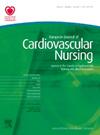Early heart rate recovery after a 6-min walking test in patients after percutaneous aortic valve implantation coresponds with clinical benefits
IF 2.9
3区 医学
Q2 CARDIAC & CARDIOVASCULAR SYSTEMS
引用次数: 0
Abstract
Background Time-appropriate return to a resting heart rate (HR) after cessation of exercise is a marker for predicting outcomes in patients with heart failure (HF). We aimed to evaluate the prognostic value of HR recovery in functional improvement in patients with severe aortic stenosis after percutaneous aortic valve implantation (TAVI). Methods 6 min walk test (6MWT) was performed in 93 individuals before TAVI and in 3 months follow up. The change in walking distance was measured. We analyzed also the differences between baseline HR, HR at the end of the test, and HR at the 1st, 2nd and 3rd minute of recovery. Results After 3 months the distance of 6MWT in TAVI patients improved by 39±63 m and reached a total of 322±117 m. The differences between HR after 2 min of recovery and baseline HR in pre-TAVI after a 6MWT was the only significant predictor of waking distance improvement during follow-up in multiple linear regression model. Conclusions Our study showes that changes of HR recovery after a 6MWT may be a helpful and easy parameter to assess improvement in exercise capacity after TAVI. This simple method can also help to identify patients in whom no significant benefit in functional improvement can be expected despite successful valve implantation.Demographics经皮主动脉瓣植入术后患者 6 分钟步行测试后的早期心率恢复与临床获益密切相关
背景 停止运动后适时恢复静息心率(HR)是预测心力衰竭(HF)患者预后的一个指标。我们旨在评估经皮主动脉瓣植入术(TAVI)后心率恢复对重度主动脉瓣狭窄患者功能改善的预后价值。方法 在 TAVI 术前和术后 3 个月内,对 93 名患者进行了 6 分钟步行测试(6MWT)。测量了步行距离的变化。我们还分析了基线心率、测试结束时的心率以及恢复后第 1、第 2 和第 3 分钟的心率之间的差异。结果 3 个月后,TAVI 患者的 6MWT 步行距离增加了 39±63 米,总步行距离达到 322±117 米。在多元线性回归模型中,恢复 2 分钟后的心率与 TAVI 术前 6MWT 步行距离基线心率之间的差异是随访期间步行距离改善的唯一显著预测因素。结论 我们的研究表明,6MWT 后心率恢复的变化可能是评估 TAVI 术后运动能力改善情况的一个有用且简单的参数。这种简单的方法还有助于识别那些尽管成功植入了瓣膜,但功能改善效果并不明显的患者。
本文章由计算机程序翻译,如有差异,请以英文原文为准。
求助全文
约1分钟内获得全文
求助全文
来源期刊

European Journal of Cardiovascular Nursing
CARDIAC & CARDIOVASCULAR SYSTEMS-NURSING
CiteScore
5.10
自引率
10.30%
发文量
247
审稿时长
6-12 weeks
期刊介绍:
The peer-reviewed journal of the European Society of Cardiology’s Council on Cardiovascular Nursing and Allied Professions (CCNAP) covering the broad field of cardiovascular nursing including chronic and acute care, cardiac rehabilitation, primary and secondary prevention, heart failure, acute coronary syndromes, interventional cardiology, cardiac care, and vascular nursing.
 求助内容:
求助内容: 应助结果提醒方式:
应助结果提醒方式:


